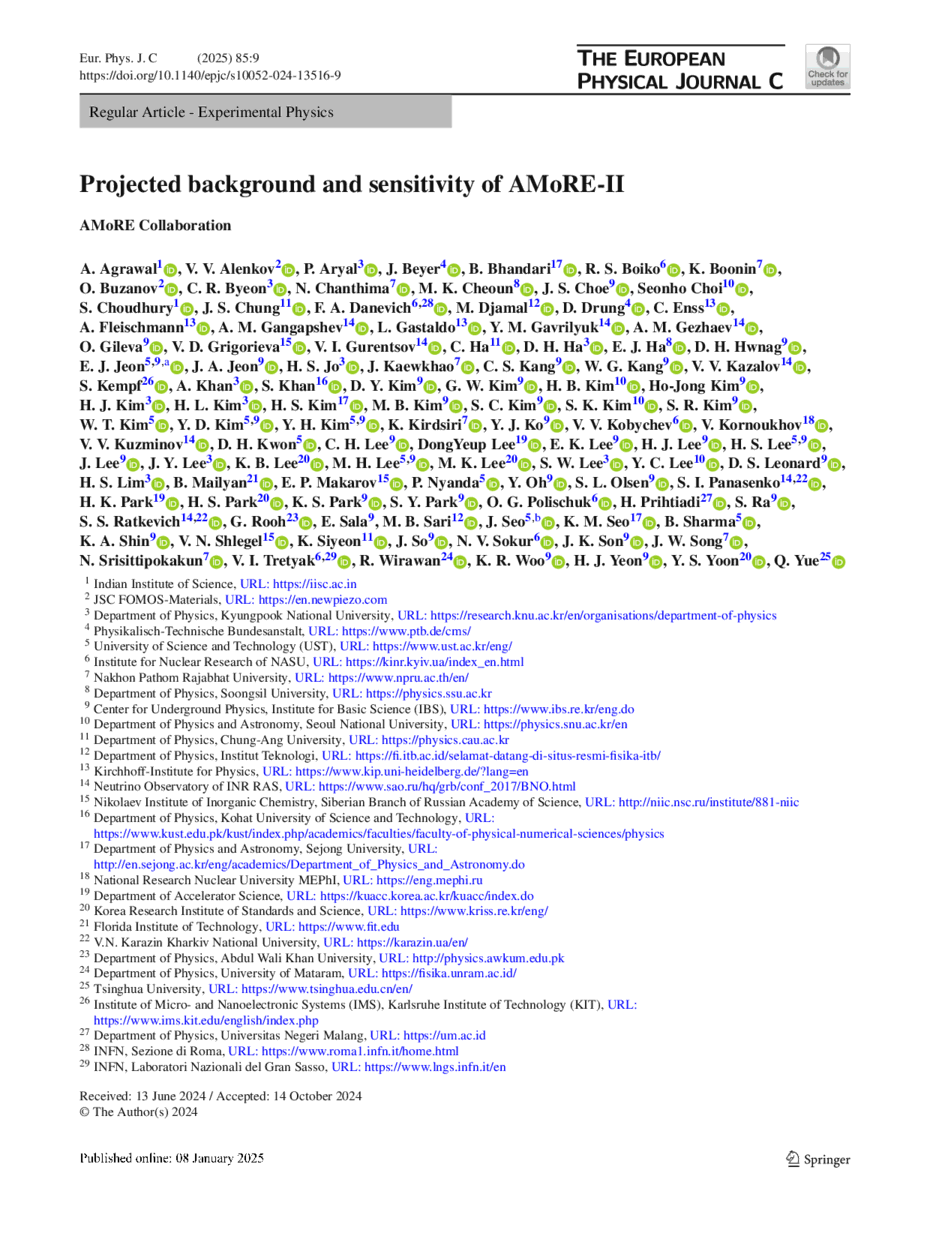https://doi.org/10.1140/epjc/s10052-024-13516-9
Regular Article - Experimental Physics
Projected background and sensitivity of AMoRE-II
1
Indian Institute of Science
2
JSC FOMOS-Materials
3
Department of Physics, Kyungpook National University
4
Physikalisch-Technische Bundesanstalt
5
University of Science and Technology (UST)
6
Institute for Nuclear Research of NASU
7
Nakhon Pathom Rajabhat University
8
Department of Physics, Soongsil University
9
Center for Underground Physics, Institute for Basic Science (IBS)
10
Department of Physics and Astronomy, Seoul National University
11
Department of Physics, Chung-Ang University
12
Department of Physics, Institut Teknologi
13
Kirchhoff-Institute for Physics
14
Neutrino Observatory of INR RAS
15
Nikolaev Institute of Inorganic Chemistry, Siberian Branch of Russian Academy of Science
16
Department of Physics, Kohat University of Science and Technology
17
Department of Physics and Astronomy, Sejong University
18
National Research Nuclear University MEPhI
19
Department of Accelerator Science
20
Korea Research Institute of Standards and Science
21
Florida Institute of Technology
22
V.N. Karazin Kharkiv National University
23
Department of Physics, Abdul Wali Khan University
24
Department of Physics, University of Mataram
25
Tsinghua University
26
Institute of Micro- and Nanoelectronic Systems (IMS), Karlsruhe Institute of Technology (KIT)
27
Department of Physics, Universitas Negeri Malang
28
INFN, Sezione di Roma
29
INFN, Laboratori Nazionali del Gran Sasso
a
ejjeon@ibs.re.kr
b
jeewon.seo.ibs@gmail.com
Received:
13
June
2024
Accepted:
14
October
2024
Published online:
8
January
2025
AMoRE-II aims to search for neutrinoless double beta decay ( ) with an array of 423
) with an array of 423  crystals operating in the cryogenic system as the main phase of the Advanced Molybdenum-based Rare process Experiment (AMoRE). AMoRE has been planned to operate in three phases: AMoRE-pilot, AMoRE-I, and AMoRE-II. AMoRE-II is currently being installed at the Yemi Underground Laboratory, located approximately 1000 m deep in Jeongseon, Korea. The goal of the experiment is to reach an exclusion half-life sensitivity to the
crystals operating in the cryogenic system as the main phase of the Advanced Molybdenum-based Rare process Experiment (AMoRE). AMoRE has been planned to operate in three phases: AMoRE-pilot, AMoRE-I, and AMoRE-II. AMoRE-II is currently being installed at the Yemi Underground Laboratory, located approximately 1000 m deep in Jeongseon, Korea. The goal of the experiment is to reach an exclusion half-life sensitivity to the  of
of  Mo on the level of
Mo on the level of  year that covers completely the inverted Majorana neutrino mass hierarchy region of (15–46) meV. To achieve this, the background level of the experimental configurations and possible background sources of gamma and beta events should be well understood. We have intensively performed Monte Carlo simulations using the GEANT4 toolkit in all the experimental configurations with potential sources. We report the estimated background level that meets the
year that covers completely the inverted Majorana neutrino mass hierarchy region of (15–46) meV. To achieve this, the background level of the experimental configurations and possible background sources of gamma and beta events should be well understood. We have intensively performed Monte Carlo simulations using the GEANT4 toolkit in all the experimental configurations with potential sources. We report the estimated background level that meets the  counts/(keV
counts/(keV kg
kg year) requirement for AMoRE-II in the Region Of Interest (ROI) and show the projected half-life sensitivity based on the simulation study.
year) requirement for AMoRE-II in the Region Of Interest (ROI) and show the projected half-life sensitivity based on the simulation study.
© The Author(s) 2024
 Open Access This article is licensed under a Creative Commons Attribution 4.0 International License, which permits use, sharing, adaptation, distribution and reproduction in any medium or format, as long as you give appropriate credit to the original author(s) and the source, provide a link to the Creative Commons licence, and indicate if changes were made. The images or other third party material in this article are included in the article’s Creative Commons licence, unless indicated otherwise in a credit line to the material. If material is not included in the article’s Creative Commons licence and your intended use is not permitted by statutory regulation or exceeds the permitted use, you will need to obtain permission directly from the copyright holder. To view a copy of this licence, visit http://creativecommons.org/licenses/by/4.0/.
Open Access This article is licensed under a Creative Commons Attribution 4.0 International License, which permits use, sharing, adaptation, distribution and reproduction in any medium or format, as long as you give appropriate credit to the original author(s) and the source, provide a link to the Creative Commons licence, and indicate if changes were made. The images or other third party material in this article are included in the article’s Creative Commons licence, unless indicated otherwise in a credit line to the material. If material is not included in the article’s Creative Commons licence and your intended use is not permitted by statutory regulation or exceeds the permitted use, you will need to obtain permission directly from the copyright holder. To view a copy of this licence, visit http://creativecommons.org/licenses/by/4.0/.
Funded by SCOAP3.





